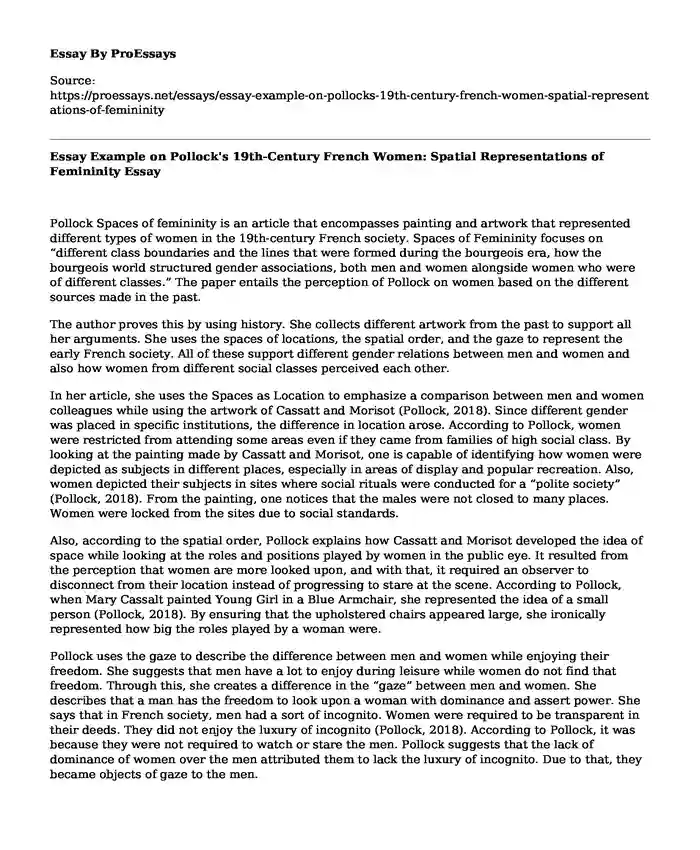Pollock Spaces of femininity is an article that encompasses painting and artwork that represented different types of women in the 19th-century French society. Spaces of Femininity focuses on “different class boundaries and the lines that were formed during the bourgeois era, how the bourgeois world structured gender associations, both men and women alongside women who were of different classes.” The paper entails the perception of Pollock on women based on the different sources made in the past.
The author proves this by using history. She collects different artwork from the past to support all her arguments. She uses the spaces of locations, the spatial order, and the gaze to represent the early French society. All of these support different gender relations between men and women and also how women from different social classes perceived each other.
In her article, she uses the Spaces as Location to emphasize a comparison between men and women colleagues while using the artwork of Cassatt and Morisot (Pollock, 2018). Since different gender was placed in specific institutions, the difference in location arose. According to Pollock, women were restricted from attending some areas even if they came from families of high social class. By looking at the painting made by Cassatt and Morisot, one is capable of identifying how women were depicted as subjects in different places, especially in areas of display and popular recreation. Also, women depicted their subjects in sites where social rituals were conducted for a “polite society” (Pollock, 2018). From the painting, one notices that the males were not closed to many places. Women were locked from the sites due to social standards.
Also, according to the spatial order, Pollock explains how Cassatt and Morisot developed the idea of space while looking at the roles and positions played by women in the public eye. It resulted from the perception that women are more looked upon, and with that, it required an observer to disconnect from their location instead of progressing to stare at the scene. According to Pollock, when Mary Cassalt painted Young Girl in a Blue Armchair, she represented the idea of a small person (Pollock, 2018). By ensuring that the upholstered chairs appeared large, she ironically represented how big the roles played by a woman were.
Pollock uses the gaze to describe the difference between men and women while enjoying their freedom. She suggests that men have a lot to enjoy during leisure while women do not find that freedom. Through this, she creates a difference in the “gaze” between men and women. She describes that a man has the freedom to look upon a woman with dominance and assert power. She says that in French society, men had a sort of incognito. Women were required to be transparent in their deeds. They did not enjoy the luxury of incognito (Pollock, 2018). According to Pollock, it was because they were not required to watch or stare the men. Pollock suggests that the lack of dominance of women over the men attributed them to lack the luxury of incognito. Due to that, they became objects of gaze to the men.
In the aspect of social stratification, Pollock uses Cassalt’s La Loge, where two women, one having shelter and the other not having it, are represented. Even though the piece of art represents the social difference between different women in 19th century French society, it also describes a conflict between a woman, her, and herself (Pollock, 2018). It shows the two sides of a woman. The woman drawn at the back seems to be aware of her weaknesses and understands that she is open to the world. However, the one at the front appears excited and thrilled by the show as she is attentive. The difference between the two shows how women from rich families looked like. On the other side, the one at the back is a subject, and she feels insecure. She understands how a subject is treated in her society.
Conclusion
I agree with Pollock in her perception of the woman in the 19th-century French society. It is because she convinces everyone by using the perfect artwork that represented the bourgeois period. In my opinion, it is among the best articles about femininity, and I recommend others to read it.
Reference
Pollock, G. (2018). Modernity and the Spaces of Femininity. In The Expanding Discourse (pp. 244-267). Routledge.
Cite this page
Essay Example on Pollock's 19th-Century French Women: Spatial Representations of Femininity. (2023, Sep 10). Retrieved from https://proessays.net/essays/essay-example-on-pollocks-19th-century-french-women-spatial-representations-of-femininity
If you are the original author of this essay and no longer wish to have it published on the ProEssays website, please click below to request its removal:
- Essay Example: Introduction to Mass Communication
- Active Empathic Listening Essay
- Creativity, Music and Painting Are My Life Passion - Essay Sample
- Comparison of The Odyssey and O Brother, Where Art Thou?
- The Magazine Cover for Teen Vogue Essay
- Dean's Garage Essay Example
- Essay Example on Evolution of Musical Composition: Middle Ages to 20th Century







